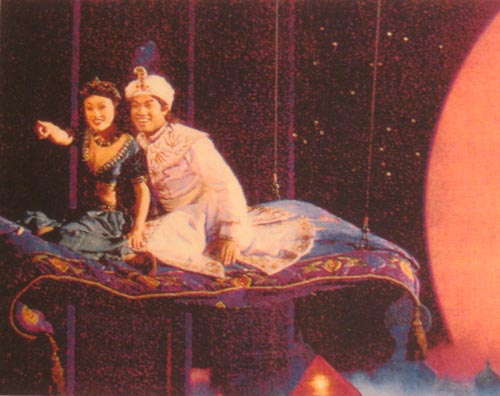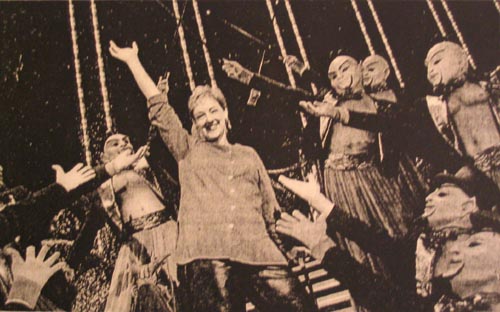Disney Enlists Theater Innovators for Theme Park Shows

Minglie Chen and Robert Pendilla in "Aladdin" at Disney's California Adventure."
Source: New York Times, January 6, 2003, The Arts, p. 1.

Minglie Chen and Robert Pendilla in "Aladdin" at Disney's California Adventure."
Source: New York Times, January 6, 2003, The Arts, p. 1.
Think Disney, and what often spring to mind are cartoon characters and animated movies. But since it hired the director and designer Julie Taymor to create the hit 1998 Broadway production of "The Lion King," this entertainment company has been playing against type by enlisting devoted theater and opera talent for new work that is dedicated to the stage, not the screen.
Broadway projects in development include "Mary Poppins," with the London producer Cameron Mackintosh; "The Little Mermaid," adapted by Matthew Bourne, who created the all-male "Swan Lake"; Ms. Taymor's version of "Pinocchio"; and "Tarzan," with music by Phil Collins (including new songs added to the score he created for the Disney animated version) and a set by the Tony Award-winning designer Bob Crowley.
Now, in what appears to be an effort to increase flagging theme-park attendance, Disney has taken established stage talent to its newest theme park, California Adventure in Anaheim, which opened in February 2001 near Disneyland. There Disney is about to open "Aladdin," a new stage adaptation of its 1992 animated film.
Times have been tough for Disney's theme park business. The company's stock dropped 10 percent last year, a result of the recession and the terrorist attacks. Because the theme-park division makes up about 40 percent of Disney's annual operating income, the company's performance depends on improved attendance.
"Disney's Aladdin: A Musical Spectacular" appears to be an attempt to draw larger crowds. The musical features songs from the film score, with music by by Alan Menken and lyrics by Howard Ashman and Tim Rice. Mr. Menken has written music and lyrics for a new song in the show, "To Be Free."
"Aladdin," which has been in previews and officially opens on Jan. 17 at the Hyperion Theater in the park, will conform to the standards of the other theme-park minimusicals that Disney has adapted from its films, playing four times a day and running a mere 40 minutes. But in its theatrical creative team and emphasis on traditional staging rather than pyrotechnics, it departs from typical theme-park fare.

"Aladdin" is the first Disney project led by Anne Hamburger, who has a new position at the company: executive vice president for creative entertainment for Walt Disney Parks and Resorts. The founder and artistic director of En Garde Arts, a theater company, now defunct, that presented events at unusual sites around New York City, she was more recently artistic director of La Jolla Playhouse in California.
"Aladdin is directed by Francesca Zambello, who has staged musicals and operas around the world: at the Royal National Theater and the Royal Opera at Covent Garden in London, and in France, Los Angeles and Santa Fe, N.M. She will direct Berlioz's "Troyens" for the Metropolitan Opera in New York next month.
The dances in "Aladdin" were created by Lynne Taylor-Corbett, who , choreographed and directed "Swing" and the Tony-winning "Titanic" on Broadway and a recent piece for Alvin Ailey American Dance Theater. The professionals responsible for the show's look include Peter J. Davison, the set designer who won a Tony Award for "Copenhagen"; the costume designer Anita Yavich; and the lighting designer Mark McCullough, the last two known for work in major opera houses. The musical arranger is Timothy Mark Williams, composer of the West End musical "Napoleon."
Arnold J. Mungioli, the casting agent for "Aladdin," primarily handles Broadway musicals. The actors have been drawn from New York, Los Angeles and San Francisco, and several have performed on Broadway as well as in the national tours of shows like "Rent," "Miss Saigon" and "The Lion King."
James A. Rasulo, president of Walt Disney Parks and Resorts, said the emphasis on theatrical talent was part of a strategy to originate work that was artistically distinctive as well as entertaining.
"Our business, like any other, has a classic nature but also needs to evolve," he said. "We are committed to continuing to push the envelope, to continue to present to our guests new, exciting forms of storytelling."
Mr. Rasulo, formerly chief executive of Euro Disney, became president of the company's parks and resorts in September, after Paul Pressler left to become chief executive of the Gap. Mr. Pressler had hired Ms. Hamburger, who in turn brought in Ms. Zambello and the rest of the "Aladdin" creative team.
Ms. Hamburger has also commissioned a Disneyland "Snow White" musical from Dara Cloud, a playwright, and Eric Schaeffer, artistic director of the Signature Theater Company in Arlington, Va., who recently completed the Sondheim Celebration at the Kennedy Center in Washington.
In, addition Ms. Hamburger said Disney was producing a new parade for Disney World's Epcot Center in Orlando, Fla. Its creators are Andrew Jackness, who recently designed the set for "Mourning Becomes Electra" at the Long Wharf Theater in New Haven, and Candice Donnelly, who designed the costumes for "This Thing of Darkness" at the Atlantic Theater Company in Manhattan.
Although its magic carpet indeed flies, this "Aladdin" leans toward old-fashioned theater, with painted backdrops. "The whole philosophy behind doing this is to take it up a notch, so theme-park entertainment is on a par with Broadway entertainment," Ms. Zambello, the director, said.
Some of the creators said that they had to make a psychological leap to work for a theme park, but that the salaries, resources and sense of adventure made the Disney project worth trying.
"In the last few years I've been making a serious attempt to do less opera and more populist-based things," Ms. Zambello said, adding that the more accessible the entertainment was, the broader the impact. "Any way we can reach out to a wider audience, we should," she said. "Something like 40,000 people could see the show in one week."
While some purists may bemoan the blurring of the lines between theater and mass-market entertainment, Ms. Hamburger called the project a positive step. "In 1975 a person like me would never have ended up at Disney," she said. "Economics have caused a lot more crosspollination." As an example she cited "Urinetown," the Tony Award-winning Broadway show that originated at the Fringe Festival on the Lower East Side. "It's healthy for the arts and healthy for the world," she said.
The park's 2,000-seat Hyperion Theater has two balconies and a 50foot proscenium stage the size of the one at the New York State Theater at Lincoln Center.
It was designed by Hugh Hardy, of Hardy Holzmann Pfeiffer in Manhattan, who oversaw the renovation of the New Amsterdam and New Victory Theaters on 42nd Street in Manhattan and the new home for Glimmerglass Opera in Cooperstown, N.Y.
"I was taken when I saw the theater," Ms. Zambello said. "I immediately saw there was a great relationship between the stage and the audience." ,
The show, which is free with park admission ($45 for adults and $35 for children), plays seven days a week. There are 18 scene changes, 250 costume changes and 2 full casts of 28 who alternate performances, as well as another backup cast and 2 stage crews.
It wasn't easy to get actors to audition for it. Ms. Hamburger said: "There was some resistance from agents: 'What? You want my client to go to a theme park?'"
At first she was wary herself, she said, having come from En Garde Arts, with an annual operating budget of $800,000, and the La Jolla Playhouse, with a budget of $6 million. (Disney will not release budget figures, but they are considerably higher.) Still, Ms. Hamburger said she felt ready for a drastic professional change.
"I've never been much interested in preaching to the converted," she said. "I've always been interested in how do you wake up people to the possibilities of what live theater can do."
"I am an entrepreneur at heart," she continued. "This allows me to be an entrepreneur with the resources of being at a multibillion-dollar company. If I can bring great artists into this division to work here, I can have an impact which is unparalleled with anything I can do in the theater."
Ms. Zambello said her Disney experience had proved to be less of a departure then she had expected. "As a director, whatever you're doing, your job is to tell the story," she said. "It doesn't really differ. Am I fully discovering the characters in a way that the audience will be drawn into it?"
Still, there have been some adjustments for the creators of "Aladdin," like having to comply with Disney's tight rehearsal timetable. "Everything is slightly compressed, which is sometimes frustrating," Ms. Taylor-Corbett said. "We're trying to infuse each other with new knowledge."
But she said she felt reassured by the show's emphasis on traditional theatrical values. "I'm so happy that it really doesn't rely on special effects," she said. "It really is about your imagination."